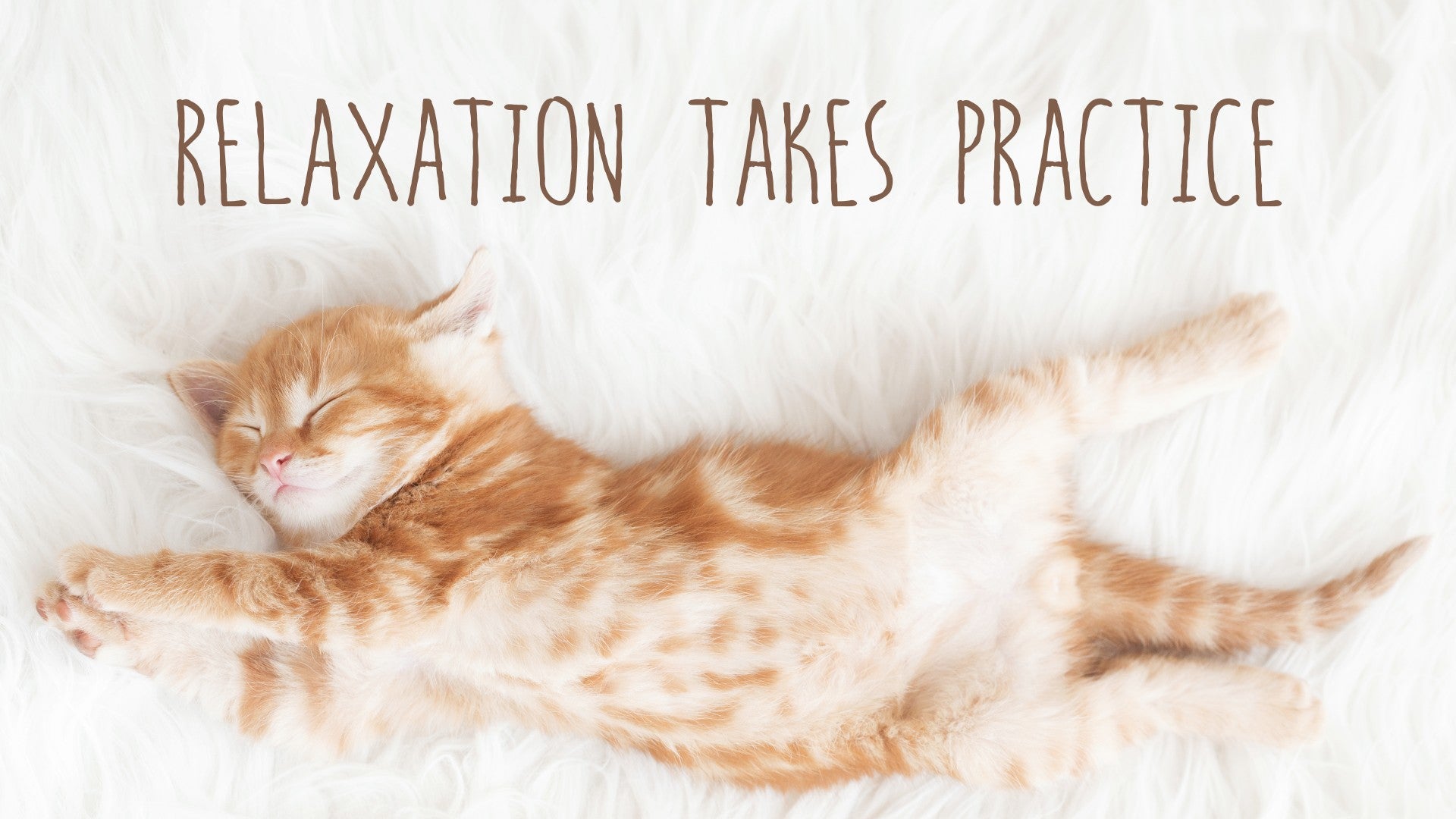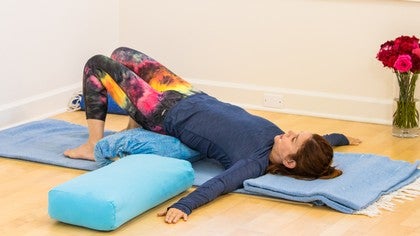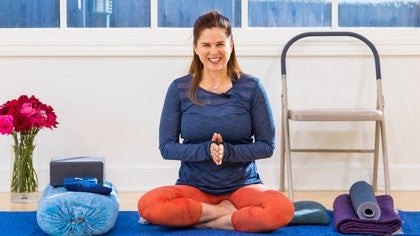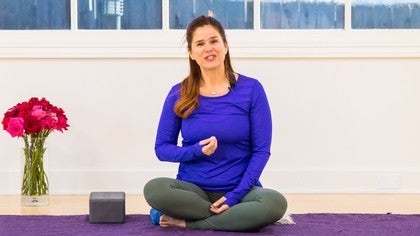Description
About This Video
Transcript
Read Full Transcript
(waves crashing) Namaste Thank you for joining me today. Today's practice is called Delicious and Deep. That sounds good already, right? This practice is a restorative practice and it is geared toward the seasoned student but don't let that scare away more of a novice student. This is welcome to everybody.
What we're starting with is a breathing practice, it's called the Four Breathing Spaces and I'll talk you through it as we go along. So let me just tell you about the props that you'll need, first. I've taken a yoga blanket and covered my mat, so it's the same size as my mat and that just makes this a little bit more comfy for us to be on the ground. And then you'll need two additional blankets and also a bolster. And I'll just be pulling whatever we need when we need them.
Let's go ahead and get started. First we're starting in Shavasana. That's good. So we're gonna take one of the blankets, I like to use this for my head. So, we're gonna bring the blanket down so that the clean folded edge is facing toward the wall.
And then I'm taking the other blanket and I'm rolling into a long roll. This is gonna be for my ankles, so I'll place that toward the very bottom end of my mat. And you might have to adjust them again once you get yourself in the supine position. This is underneath my knees and my thighs. And so I'm going to start to move in the position.
I'm gonna bring this one a little closer to me. It's different for everybody. Some people like it a little closer to the calf, some people like it really tucked underneath behind the ankle and the heel, but whatever feels comfortable for you. I'm gonna move this so it comes just underneath my skull. And feel free to double up, the height of the blanket as well.
We're gonna be here for a good ten minutes. So once I get myself settled and feel grounded, the first breathing space, it informs the lower belly, the tailbone, the sacrum and a little bit of the lower back and it's about the movement of the breath and the access that we have to this area of the body. So we're starting by taking our hands only about, it's like six, seven inches or so, six to eight inches away from the hips. With the palms turned up toward the ceiling and the arms very relaxed, let's go ahead and close our eyes. And at first it may feel a little awkward to have our arms so close, or it may feel very comfortable for you.
For me, it's a little tight. But what it's giving me an opportunity to do is explore this area from my hands, the space between my hands and my hips. So I want you in your mind's eye to imagine that space that exists between the arms, the inner borders of the arms, the outer borders, the outer borders of the hips. It's like this sliver. And then as you start to initiate your breath around the lowest part of the belly, imagine that you could take your breath into that space.
So it's not just the breath is traveling upward, but it's also traveling outward. I'll just take a couple of breaths there, noticing how your arms in this position inform other parts of the body in terms of their movement or non-movement. And can you be a little curious of the movement of the tailbone and the sacrum and the lower back with each inhale and exhale. And then notice what it feels like to live in this area of the space from the arms to the hips. Notice any kind of access that you have or feel that you don't have to the breath with the arms this close to the hips.
Then go ahead and take one more inhale and exhale there. And then we're gonna pull the arms out, just a little bit. So let's slide them out, maybe about six more inches. You're not all the way out to the sides yet, but a little further out, getting closer. And again, those palms just turn up, you can let the weight of the shoulders release.
Now you've increased that distance, right? That space between the borders of the arms and the legs and now more of the torso. So in your mind's eye, see that space. This is the second breathing space and it has a relationship more with the rib cage and the side, front and back waist. And still initiate your breath around the belly.
Imagine that the breath is again, not just going up but it's going out. So the breath is now a little rounder, a little more global, more multidimensional. And just notice the access that you have to the breath now, to the fullness of the breath, depth of the breath, even the length of the breath. Then notice those parts of the body, still the tailbone and sacrum and the lower back and the belly, but also begin to notice the side, the front, the back waist and the rib cage. Notice the movement and the general access to the breath.
And then listen to maybe another breath or two. Feel your way into them. And then we're gonna slide the arms out a little further and you can open your eyes and glance over at one arm. I'm just rolling my head to the left and letting that left arm come out so I can see that my hand is in the same plane as my shoulder. Then I'll roll my head over to the right side and just slide this arm out and see that that shoulder and hand are in the same plane.
So, I'm really in that classical "T" position. And then we'll just roll our head back to the center and let's close our eyes again. Now, we've increased so much space, so much distance between the outer border of those arms. Imagine that you could draw a line from the armpits all the way to the fingers and then right down to the legs. All the way down toward the feet.
And then, now you have, perhaps a little more access to the chest. And start to explore the breath. Still initiate around the belly. See if you can get the breath to be open, and round and soft. And you're not forcing the breath from the ribs up into the chest.
You're just noticing the level of access that you have to them as a result of the arms now in this different position. Notice what it feels like to live in this new space that you've created by moving the arms wider. And once again, listen to the breath that you're taking. And go ahead and take two more breaths in this third space. When you complete that second breath, we're going to go to the fourth and last breathing space.
And all we have to do is just bend the elbows so that your hands come parallel to the skull. And if the wrists don't touch all the way to the floor, it's okay. If your hands are floating, it's okay. You may be just a little uncomfortable but this is something to explore unless you're in pain of course. You know, release your arms out a little bit, give yourself some room.
And I'm gonna roll my head again to the side, just to see. Sort of got these cactus-shape arms or goal-post position arms. Shoulders and elbows still in the same plane, but now hands up overhead. And this is a really, really different and unique space to explore. Now imagine that you have all this distance.
You're sort of drawing a half circle overhead. From one hand all the way over your head and to the other hand. And is it possible to draw the breath just as much out as up? From the belly, through the waist and ribs and the chest and even up through the throat and the neck. But to include that space up overhead.
And as you breath, just pay attention to the level of comfort that you have. Then go ahead and listen to the breath that you're taking and take two more. When you finish the second breath, bring your arms in the position that you felt you had the most access to the breath. The most movement through the spine, all the segments of the spine. The arms have a direct connection to those four segments of the spine.
The tailbone, the sacrum, the lower back, mid-back and the upper-back. And then you'll just rest here about another 30 seconds, in the position that you feel the most comfortable with, the most access to a relaxed and steady breath. Listen to the breath that you're on and complete one more. And then, wherever your hands are, go ahead and let the right arm move in toward the chest. And let the right leg bend so that that foot comes flat to the bolster.
Just pause when you get there. And then push off with your right foot, slide your hips a little bit to the right of the mat, roll yourself to the left so that you're in a fetal position. And go ahead and lean your chest into the floor. Open your eyes, press with your right palm and slowly begin to push up. And when you come up, just sit and pause for a few moments and then we'll prepare for the next pose.
So, we're gonna move into the next posture which is supta baddha konasana, and that's supine bound ankle pose, with lots of support. And I just wanna mention that we did these four breathing spaces and now we're doing poses that try to open up those areas that we explored. And so you may find that you wanna move your arms in a sort of non-traditional bound ankle pose and that's perfectly fine to do. The idea is to try to find a place where you can really get that access to your breath. So here we go.
You need two blankets and one bolster. We're gonna move the bolster to the top of the mat now. And it's parallel to my mat and most people like to practice with a blanket underneath their head. You can be very fastidious about your blanket fold because it's supporting your body. You have lots of options: you can make this blanket a lot thicker than mine or you can pull it out and not use it at all.
So I just place that clean folded edge toward the wall 'cause it's gonna be supporting my head. And then this other blanket, we're gonna unroll it from where it was and we're gonna open it up into a very long roll. It's just like the blanket that's on the mat. And from here, we're gonna roll it into a nice tube. And I'm doing the long version because I'm not long, but many of you may be.
It's okay, also, to just fold it in half as it was and have a shorter tube, but this will pretty much work for someone who's a little taller than maybe 5'5', 5'6'. So this is gonna go around our ankles and support the top of the thighs where the heaviest part of the leg is. So it looks like this. I bring the soles of my feet together. It makes no difference where your feet are in relation to your pelvis.
Do not force your feet in to take the feet closer in so that you can get a deeper stretch. The idea is to have the knees pretty much in the same plane as the hips, as the hip line. So, if you find you're tighter one day, maybe you take your feet forward a little bit. I'm gonna start with my pelvis right up against the bolster, but some of you may wanna have a little bit of distance, and if that's the case, just push the bolster back a little bit. You'll be bringing more of your back ribs on top of the bolster as opposed to the lower back.
So then I'm gonna take this blanket and I'm gonna bring it around the top of my feet. And then around my legs, just like a little horseshoe. It's a nice little harness and you can see that I've brought it pretty close to the top thighs. And I push my hands down on the back end of the bolster, lift my chest as I begin to lower and right when my back touches the bolster, I slide my buttock flesh toward my feet and then begin to lower myself. I adjust the blanket so it fits right where I want in my head.
(sighs) Take a breath. I find my spot. I like my arms out to the sides in this position, with my elbows softly bent. We'll be here for about three and a half minutes. I let the weight of the pelvis and the legs get really heavy.
Because the belly is so exposed here, I may find an opportunity to explore the breath around that area. And also, up a little higher, toward my waist and ribs. Sometimes I like to bend my arms, slide those edges of the blankets out and rest with my palms down, especially if I feel like too much gravity is putting too much load on my shoulder with my arms hanging. This is a nice variation. I think it's one that I'm gonna stick with in this pose right now.
You might also find that as things begin to open up and soften that the head support may need to be modified. In my case, I'm gonna go ahead and do that now. Sliding the blanket out, away from my head. And can you return to the curiosity of the movement around the belly, the sacrum, the lower back, the waist, the ribs and invite that global round breath. So, we're just about at three and a half minutes, I'm going to invite you to stay in a little bit longer.
If it feels like you need a little less sensation, in the inner thighs, then go ahead and straighten the legs out or you can come out of the pose altogether before you hear the instruction to do so. Let's see if we can stay just a little bit more, and deepen the relationship with the breath. So go ahead and notice the breath that you're taking right now. Listen to it. And take three more breaths.
When you finish that third one, go ahead and slowly begin to let your hands come to the tops of the thighs. You're gonna push down with your hands and slowly guide the legs to a straight position. Let your arms just be placed wherever you want them. We're just pausing here. To come out of the pose, we'll bend the right leg and set that foot flat on the floor.
And then bring the right arm in toward the chest. Slide your left arm out just a little bit to give yourself some room. And then sweep your hips over to the right a little. Bend the left leg and roll all the way off the bolster and to the left. Once again, just pause.
Let's lean the chest into the floor, open your eyes, gently, push into your right palm, bring your head up at the last moment. Sit in any comfortable seated position, close your eyes, and pause again. So I'm gonna go ahead and get a second bolster for the next pose, tatar parvatasana, which is a twist on the back side of the body. So let's set up for the twist. I'm going to take one bolster and bring it to the side for right now.
That's going to go underneath my hips, but I'm gonna slide it underneath, it'll be a little easier. And then, I'm gonna remove this blanket, 'cause we really don't need it right now. But we'll need it later, so I'm gonna unroll it and just roll it up or just fold it up, and place it to the side. Okay. One bolster, the long edge goes parallel to the length of the mat.
The other one we can just push out to the side for a moment. Come down on the back. And slide this other blanket so it comes underneath my head and I have a little bit of support. Lift the pelvis and take the bolster and bring it right underneath the lower back. Then I'm gonna shift my hips over to the right side, bring my arms out to the side.
I'm gonna line these two bolsters up 'cause my legs are also gonna rest on this bolster. Pick up both of my legs, press the palms flat to the floor, keep my right arm and shoulder on the floor. And as I exhale, slowly begin to lower the legs to the left. And what I want to see is that from the right chest to the right hip, there is a straight line. I'm gonna go ahead and slide my upper back to the left just a little bit.
And then I can maintain the twist here. Now I can turn my palms up to the ceiling. You may feel right away the new opening that you have, in the ribs and in the chest. But the idea is not to brutally force yourself into the shape. Rather it's to soften, to relax, and explore that second and third breathing space, the ribs and the chest.
Let's be here for about two minutes. The elevation of the pelvis will give you a little bit more stretch on the top leg. If it feels like it's too much, you can always place a rolled blanket or a bolster between the legs as well. And after about a minute or so, you may feel as though you can deepen in this a little more. If that's the case, just turn your left palm flat to the floor, take an inhale, lift the left upper back again, press the left palm, get more of that right shoulder to rest on the floor.
And then you can turn your palms up again. Return to that round breath a couple more times. Listen to the breath that you're on. And then if your head is turned away from your legs, just bring it back into the center. And to come out, you're gonna bend your left arm, bring it in towards your chest or your belly, and you're gonna take your top leg, pull it in towards your chest, follow with your other leg, until you're into the center.
Set your feet flat on the floor, adjust your lower back on the bolster so it's square, bring your arms out to the sides and here we're pausing. So to move into the other side, from here I can just grab ahold of that bolster, pick it up, bring it over to the other side, line it up, just as I had earlier. And now I'm gonna come a little closer to the bolster and then slide my pelvis to the left, pick my legs up, turn my palms flat to the floor, and exhale, bring my legs to the right. Then I'm gonna pick up that upper right back, bring it to the right a little bit more, just so that I can see that my chest, my left chest and my left hip are pretty much in the same plane. Then I can open the palms up toward the ceiling.
Relax and melt into the floor with my shoulders and my bottom hip, let it relax and melt into the support. So, now we're gonna go ahead and be in this shape for about that two and a half, three minutes. Remember that each time you come to the yoga poses that affect opposite sides of the body, you may bump up against some challenges or some restrictions. You may also come up against some real opening. I love doing the twists because they're really an opportunity to reconcile differences in the body-mind.
In here, it's a unique opportunity to explore this second and third breathing space. Think of the breath as not something that you're going to try to force, it's more important that you pay attention to the quality of the breath and that you remain sensitive to it. The depth and length are not as important. If you do find that you've opened up a little more, you can turn that right palm down and use it as leverage to rotate a little more in that mid-upper back. So let's listen to the breath that you're on right now.
And complete another two breaths. And then we'll go ahead and let that top leg slowly begin to come in toward the body and the bottom leg. Then you'll set those feet flat on the floor, and just slide your pelvis so that it's in the middle. We're gonna actually remove the bolster now from underneath the back. So push the feet, left the pelvis, just enough so you can slide it out.
Bring it to the side and begin to lower yourself slowly. You may wanna rest your inner knees up against one another and sort of turn your toes in a bit. And go ahead and put your arms in the position that you really liked when we did the four breathing spaces. And make a little comparison as to the access to the breath that you have now and the one that you had earlier when we did the exploration. Then we're gonna roll over onto the side.
Take your right hand, let it move in towards your chest, and slide your hips a little bit to the right of the mat. And then roll slowly over onto that left side. Into a fetal position. And go ahead and lean your chest into the floor, push with your palm, slowly begin to come up, and sit in any comfortable seated position. And just pause.
So let's go ahead and move into viparita karani, which is legs up the wall with the bolster. So this one you just need one bolster and one blanket. I'm gonna go ahead and push the other bolster out of the way. And we're gonna keep this bolster to this side and we're gonna move the blanket for my head little closer toward me. Can adjust it again once we get up into the pose.
We're sliding our hips very close to the wall and then legs go up the wall. Bend the knees, grab ahold of your bolster, push your feet into the wall, and then we just lift the pelvis, slide the bolster underneath the lower back and pelvis. And it's a couple inches away from the wall, so that my hips can sink a bit. That requires me to kinda wiggle myself a little closer so I'm gonna do that now. Slide the blanket underneath the head, coming a little closer and then straightening the legs up the wall.
And for this position, invite yourself to put your arms in the position that you really felt great access to the breath. One of the four breathing spaces. For me, that's the arms in the last position. By the way, you should know that one is not more advanced or better than the other. They're all just indicators and inquiries to us, as to where we have access to the breath.
Once you get your body in the position, you can begin to sink your weight fully into the support. Including the ground beneath you. Close the eyes. And we'll be here for about four minutes. At any time, if you feel like you need to make any adjustment, go ahead and do it.
Just do it mindfully. And is it possible for you to capture that breath that starts around the belly and grows globally toward the chest and skull, without force. Once again recognizing that sensitivity to the quality of the breath is more meaningful. As I continue to open, I notice that I'm starting to collect a little bit of tension in my neck. Which is an indicator that I no longer need a blanket underneath my head.
So I'm going to gently push it out of the way. (gentle sigh) And then my shoulders really settling. We're rounding out the last minute here, so listen to the breath that you're taking and go ahead and take three more. And then when you're finished, just go ahead and bend those knees again. Follow the same steps you took to get in.
We'll press the feet, lift the pelvis and slide that bolster out from underneath you until the lower back hits the floor. You can keep the knees bent or you can straighten the legs, whatever feels good. And then we'll pause on the back. It's important to take your time to come out of the supported inversion because the blood pressure needs to stabilize again. There's never a hurry or a rush to move in or out of the pose.
When you feel ready to make more movement, go ahead and bend those legs again, roll over to your left side, take your right arm with you, 'til you're in that fetal position again. And pause. Then lean your chest into the floor, use your right palm to push and come up. And then we'll sit for just a moment or two. Closing the eyes.
Feel a difference of what it's like to be upright, after being in the inversion. It really does take some time to settle. And then we'll prepare for the final pose which is shavasana. I'm looking forward to it, and I'm sure you are too. Okay, so starting to set up for the shavasana.
I've got my bolster for my knees and thighs. There's also another option: to place it on top of your thighs if you want. So, I'll give you the option to try either one. The eye bag, and I'm gonna place the blanket at the very top of my mat for my head. Bring the bolster closer to you.
Start to pull your pelvis forward until you get your knees and your thighs right on top of it. This is an important cue for you to know: you want your heels to touch, not float. If they were floating, we put a blanket there to support that space. So come far enough forward with your legs so that those heels can touch. And then you'll start to lower yourself.
Then I adjust the blanket so it's just underneath the skull, 'cause that's where I like it. Grab the eye bag. I'm gonna just place it on the belly for a moment and adjust my shoulders. And then I'm gonna relax the skin from the top of my forehead down toward the eyelids. So that that area can really receive the weight of the bag.
Placing the bag on the forehead, bring the long edge of the bag just to the top of the forehead where it meets the scalp and then slide it down so you feel the skin moving down toward your chin. And then just place the eye bag so that it does take out the light. And you like the weight that's on the eyes, not the nose. And then let your arms go in the position that allows you to have access to a breath in this shape. For those of you who like that fourth breathing space, like I do, don't worry that your arms are overhead.
As long as you keep your shoulders in the same plane as the elbows, it's okay for your hands to be up. Now we start the relaxation process. Go inside. Get quiet. Commit to being still.
Deliberately relax the weight of the body into gravity. And commit to being still. So, in order to come out, let's go ahead first and remove the bag. And the way that we'll do that is hold on to the outer edges of it, keep the eyes closed but slide the bag toward the back of the head. Then we'll bend the right knee so that that foot comes flat to the bolster.
The right arm in toward the chest. Push off that foot and roll slowly to the left. You're back in that fetal position. Pausing, doing nothing. Then place your right palm up against the ground, lean your chest into the floor, push to come up.
We'll return to a comfortable seated position. Eyes closed. Join the palms at your chest. Thank you for sharing this deep practice with me today. Bow your head towards your heart.
Namaste.
Relaxation Takes Practice
Comments
You need to be a subscriber to post a comment.
Please Log In or Create an Account to start your free trial.
















